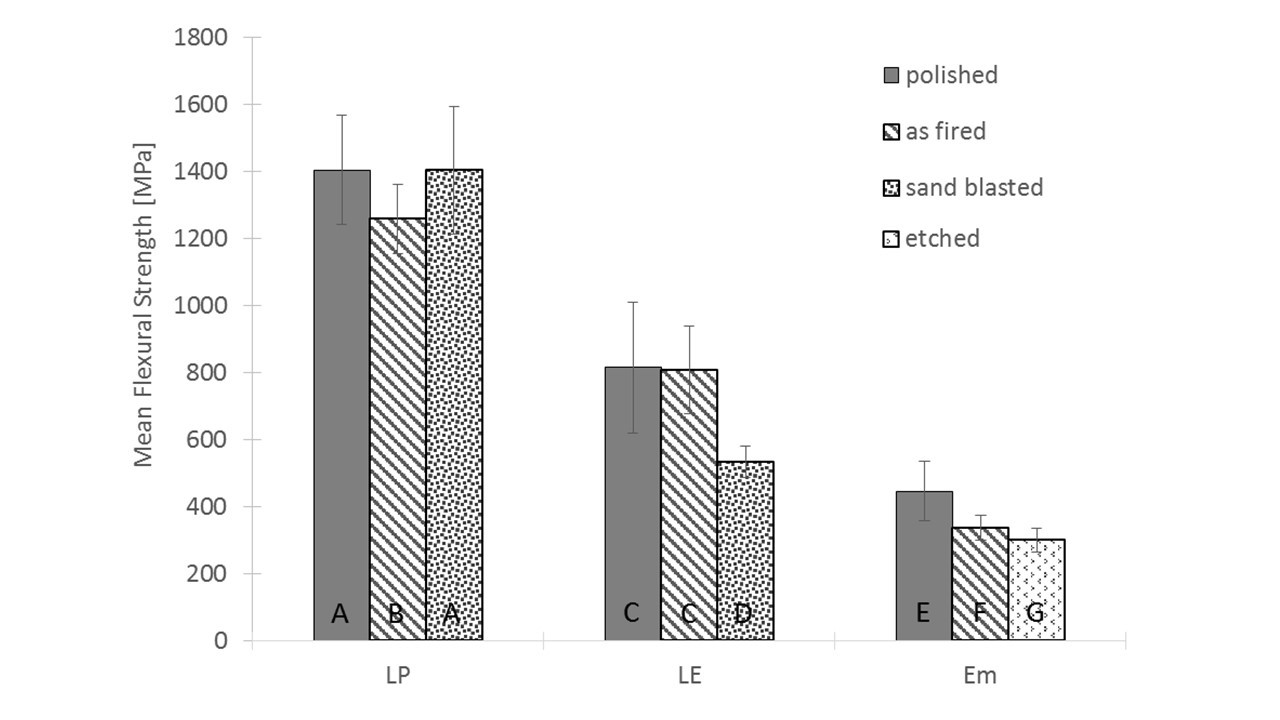IADR Abstract Archives
Flexural Strength of a Novel Esthetic Full-Contour Zirconia Compared to Other Ceramics
Objectives: In this study the flexural strength of various ceramic restoration materials including a novel zirconia product was investigated. Different surface preparations which appear on final restorations have been tested for each material.
Methods: Bending bars were cut from CAD/CAM mill blanks, chamfered and sintered or crystallized and prepared to final dimensions (16x4x1.2mm). The investigated materials were 3M Lava Plus High Translucency Zirconia (LP), 3M Lava Esthetic Fluorescent Full-Contour Zirconia (LE) and Ivoclar IPS e.max CAD (EM). Each material sample set was divided in three groups (n=30). One group of each material was tested “as fired” without further treatment and one was polished acc. ISO6872:2015. A third group was treated according to cementation recommendations by sand blasting (2bar, 50µm Corundum) for zirconia or an etching step (IPS Ceramic Etching Gel) for glass ceramic. The bending bars were loaded until fracture in a 3-point-bending setup.
Results: Mean flexural strength (FS) acc. ISO6872:2015 results are summarized in table 1 and visualized in diagram 1. 2-sample-t-tests (p<0.05) have been performed for all groups. Groups with significant difference are marked with the different letters in table 1. Mean FS of the three investigated materials differs significantly from each other independent from surface preparation in following order LP > LE > EM. Compared to polished groups the samples with surface preparation required for cementation resulted in significant lower FS for LE and EM materials and showed no significant difference for LP.
Conclusions: The significant different FS values of the three tested materials need to be considered for restoration design and indication range. LP allows widest indication range. The novel zirconia LE exceeds with all tested surface preparations the recommended ISO6872-2015 limits for Type II, Class 4 indications which supports the use of this material for 3-unit bridges in anterior and posterior situations. EM is limited to 3-unit bridges anterior. This is also reflected in the minimum occlusal wall thickness (for posterior LP 0.5mm, LE 0.8mm, EM 1.5 mm).
Methods: Bending bars were cut from CAD/CAM mill blanks, chamfered and sintered or crystallized and prepared to final dimensions (16x4x1.2mm). The investigated materials were 3M Lava Plus High Translucency Zirconia (LP), 3M Lava Esthetic Fluorescent Full-Contour Zirconia (LE) and Ivoclar IPS e.max CAD (EM). Each material sample set was divided in three groups (n=30). One group of each material was tested “as fired” without further treatment and one was polished acc. ISO6872:2015. A third group was treated according to cementation recommendations by sand blasting (2bar, 50µm Corundum) for zirconia or an etching step (IPS Ceramic Etching Gel) for glass ceramic. The bending bars were loaded until fracture in a 3-point-bending setup.
Results: Mean flexural strength (FS) acc. ISO6872:2015 results are summarized in table 1 and visualized in diagram 1. 2-sample-t-tests (p<0.05) have been performed for all groups. Groups with significant difference are marked with the different letters in table 1. Mean FS of the three investigated materials differs significantly from each other independent from surface preparation in following order LP > LE > EM. Compared to polished groups the samples with surface preparation required for cementation resulted in significant lower FS for LE and EM materials and showed no significant difference for LP.
Conclusions: The significant different FS values of the three tested materials need to be considered for restoration design and indication range. LP allows widest indication range. The novel zirconia LE exceeds with all tested surface preparations the recommended ISO6872-2015 limits for Type II, Class 4 indications which supports the use of this material for 3-unit bridges in anterior and posterior situations. EM is limited to 3-unit bridges anterior. This is also reflected in the minimum occlusal wall thickness (for posterior LP 0.5mm, LE 0.8mm, EM 1.5 mm).


